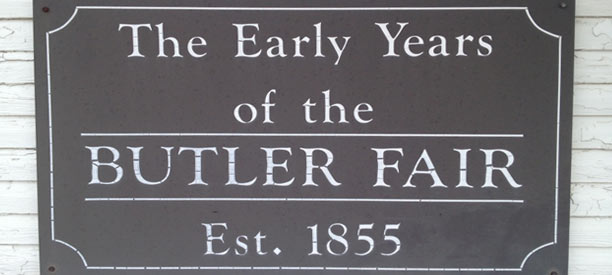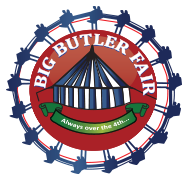History
Though established in 1855, the first Butler Fair was held in 1856 on a plot of land east of Kearns Crossing. The next year, the Fair moved to a site near the Pullman-Standard plant. Joseph Douthett was the first president of the Fair’s association. Under his direction, the Fair prospered until its activities were curtailed by the Civil War.
That same year, the Butler Agricultural and Stock Association was formed to spearhead Fair activities, with Judge James Braden as president. Eleven years later, the Butler Driving and Fair Association took over, with G. J. Cross stepping in as president. To further the development of the Butler Fair, a 33-acre plot was leased and a half-mile race track was built, along what is now Hansen Avenue. In the tradition of county fairs, the association presented outstanding exhibitions of livestock and farm products, as well as harness racing featuring well-known drivers and locally-owned horses.

Growing ever more rapidly, the Fair purchased additional land in 1888. Under the name of the Butler Agricultural Association, the Fair was a successful annual event thru 1902. That same year, the Standard Steel Car Co. purchased the Fair property, building a plant to manufacture steel railroad cars. Thus, after 45 years, the Butler Fair moved from their established location.
In 1903, the Big Butler Fair continued its activities on a 60-acre hilltop property west of the city. George A. Shaffner directed the development of the new fairgrounds, complete with cattle sheds, midway, race track and grandstand. By this time, Fair Week in Butler County had become the most colorful annual event in the district. Local merchants in the City of Butler closed their stores at least once a week for a time of summer holiday and homecoming. For the rural areas of the county, the Fair meant basket picnics and family reunions, for the youngsters it was an unforgettable week of carnival time.
When World War I broke over the nation, the policies of the Fair Association changed with the changing way of life in America. Automobiles, radio, paved roads and mechanization of farming brought new and different exhibitions and attractions to the fairgrounds. In 1928, Mr. R. J. Ferguson became the president of the Fair, and under his leadership the discouraging years of the depression were weathered by the Association. World War II continued the difficulties, but on August 15, 1945, the Butler Fair and a hysterical crowd celebrated the victorious Cease Fire of V-J Day.
Following this uncertain era, the Association converted into a nonprofit, with Mr. A. J. Richards, son-in-law of Ferguson, as president. By this time, however, the expansion of the Butler area had caught up with the Fair. In 1956, the Fair’s property was selected by school authorities as the site for a new ultra-modern high school. After considerable confusion and much discouragement, the Butler Fair was reestablished in a new setting on Route 422, eight miles west of Butler and adjacent to Prospect.
Roads were laid out, graded and paved. Buildings were moved from the old location. New, permanent buildings were erected, anew race track was constructed and so a new Butler fairgrounds came into existence.
The Big Butler Fair, still at its longtime home in Prospect, continues in the old tradition and is still a much anticipated summer activity for Western Pennsylvanians. Approximately 4,000 exhibitors will attend the Fair this year with various projects, and we can’t wait!
